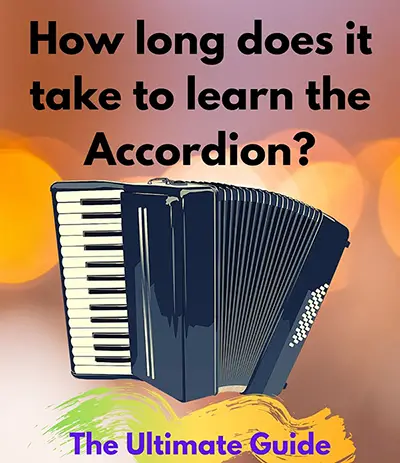
Maybe you are a beginner just starting or you have been wanting to play this amazing instrument for quite some time and finally, now you are ready to buy an accordion. You’d like to know how long it takes to learn to play the accordion, but as you can imagine, there’s no formula to guess the correct answer to such a question. Based on my experience, I can give you some timelines:
| Skill levels | Time needed |
|---|---|
| Beginner | between 2 and 8 weeks |
| Intermediate | between 1 and 2 years |
| Advanced | between 3 and 5 years |
| Expert | more than 10 years |
- Beginners learn to play their first simple piece within 2 weeks up to 2 months.
- Intermediates are able to play moderately difficult pieces and it usually takes at least 1 or 2 years to reach this level but it could take longer.
- Advanced are those accordionists who usually can play very well one or more musical genres, they have a fair knowledge of harmony and fine technique on both hands. They are accordionists who have at least 3 or 5 years of experience.
- Expert accordion performers can play any genre, in any style. Their repertoire is huge, they have achieved a very high level of technique and deep knowledge of the accordion. In this case, we are talking about decades of practice and performances.
Playing easy pieces with the accordion at a beginner level it’s not so hard.
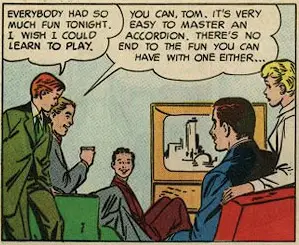
The accordion is one of the very few instruments that allows you to play 4 types of complete chords by pressing a single button. This is a huge advantage because you don’t need to learn how to build chords before you can play them. Usually, all my students can play easy stuff with both hands in one or two months but everyone’s learning pace and style are different.
Progress timeline
Day 1:
Your first accordion lesson should focus on posture. If there is no teacher to guide you, I advise you not to neglect this topic as you could compromise and slow down your progress. Take a look at this article: How to hold the accordion – Sitting & standing position
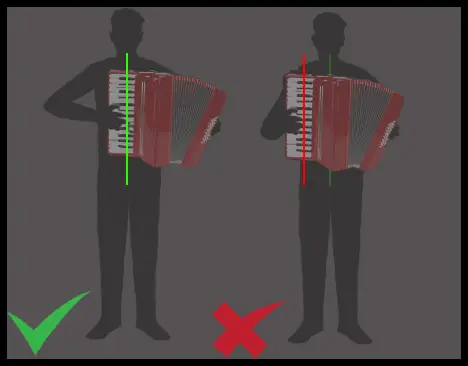
Within 2 weeks:
During the first few weeks, you will begin to develop muscle memory that will allow you to properly position your fingers on the keyboard and on the bass button-board. You will begin to become familiar with the Stradella system layout. You’ll be able to play a simple bass accompaniment and perhaps even to play simultaneously a melody with your right hand.
Within 1-2 months:
You will play simple accordion exercises and easy pieces in major and minor keys with alternating bass accompaniment.
Within 6 months:
You will be able to play simple accordion pieces of traditional music or facilitated arrangements of classical music using all chords available on the button board.
Within 1 year:
You can play moderately difficult pieces in a proper way.
After 2 years:
You will start playing difficult pieces, paying attention to details, dynamics, and expression.
Key factors
Everyone is different and the time it will take to get to a certain level will depend on a number of key factors that I am going to list. I’ll start by talking about some of the factors that will determine how long it takes to learn the accordion. These factors will give you a big picture of the roadmap of your journey in knowing your instrument. Along these, I’ll be giving out bonus practice tips that will help you in playing the accordion easier and faster.
So enough of the introduction and, let’s dive right in. Factors that determine how long it takes to learn the accordion are as follows:
- Goals
- Age
- Natural talent
- Past musical experience
- Self-taught vs. taking lessons
- Amount of practice
- Quality of practice
- Motivation
1. Goals
Before we even talk about the factors that influence the amount of time it takes to learn to play the accordion, we must first establish how far the goal is. We can not compare the time it takes to go to the grocery store downstairs with a circumnavigation of the Earth on foot.

Learning to play basic arrangements of traditional and folk music is a completely different goal than wanting to be the next Richard Galliano. The first is most often reachable in less than 2 months, the second one takes a lifetime. So just as the traveler knows the length of the route, you also need to know how ambitious your goal is to get an idea of how long your journey will be. The time it will take you to learn to play is directly proportional to your ambition.
2. Age
You can start playing the accordion at any age but your expectations should fit the reality. Growing up doesn’t only mean changing physically and psychologically: as we age, our habits, our responsibilities, and consequently the time and energy we have available also change.

We can identify 5 age groups:
- Kids (3 – 9 y.o.):
- Pre-teens & teenagers (10 – 17 y.o.)
- Young adults (18 – 27 y.o.)
- Adults (28 – 44 y.o.)
- Middle age (45 – 64 y.o.)
- Aged (more than 65 y.o.)
Kids (3 – 9 y.o.)
This is the best age group to start practicing an instrument. Kids have little or nothing to worry about, they are always open to learning new things. They do not have a job as an excuse not to practice their instrument. Although, they might want to play with their friends instead of rehearsing, nevertheless, it is very much easier to control and discipline them. The benefits of learning an instrument at a very young age are numerous and it is widely encouraged by pedagogies.
Most of the best accordionists started at a very young age:
| At what age did the most famous accordionists start playing? | Age |
|---|---|
| Richard Galliano | 4 y.o. |
| Charles Magnante | 5 y.o. |
| Guy Klucevsek | 5 y.o. |
| Alexander Hrustevich | 6 y.o. |
| Frank Marocco | 7 y.o. |
| Sivuca | 9 y.o. |
| Art Van Damme | 9 y.o. |
| Marcel Azzola | 9 y.o. |
| Stian Carstensen | 9 y.o. |
Pre-teens and teenagers (10 – 17 y.o.)
In this age group, pre-teenagers and teenagers may decide to play an instrument for different reasons. Discipline may not be there in this age group because they have more than enough things to keep themselves busy with. You name it! School, friends, sports..their first love, etc! But it is possible to begin as well, many have done this in the past and have grown to be very exceptional instrumentalists.
Young adults (18 – 27 y.o.)
This is one age group that owns a lot of new responsibilities. Many move out of their parent’s homes to live independently. The hustle is real as they try to fend and feed for themselves. Learning the accordion at this age group could be tough but it is not impossible. With proper planning and dedication, they can still become successful accordionists.
Adults (28 – 44 y.o.)
Most have kids in this age group, many are working hard and it could be tough to dedicate time to practicing the accordion. At this stage, they might just need 45 minutes to practice every day. This could add up to a lot and progress is certain.
Middle age (45 – 64 y.o.)
Some of those in this age group have grandkids, some are retired, and some are at the peak of their careers. Finding time to practice an instrument could be difficult or it might be the best time of their life to start playing. It takes serious determination and discipline to practice every day.
Aged (more than 65 y.o.)
It’s possible to learn the accordion at this age, it can be done, it will be a little difficult, especially for someone who has never played an instrument but still want to play hard pieces. In a relatively short time, they can play for their family or have a good time with friends. In my experience, my older students compensate for the disadvantages of their age with an iron discipline, very rare among the younger ones. So, don’t be discouraged, it’s never too late to start playing the accordion.
3. Natural talent
Today we tend to deny the value of innate talent: it is true, there are many more important elements than talent but your natural predisposition is certainly a factor that affects the time it takes for you to learn to play the accordion. We are not all the same, there are those who are gifted for sport, those who have a natural predisposition for cooking, those for drawing and painting, and there are those who know how to sing very well without ever having taken any lessons.
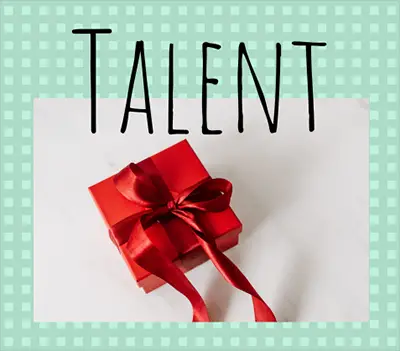
Talents exist and are among us, we must not fear them, we just have to be aware of them.
If you are very talented there’s a big chance that you will overestimate your skills and this is a worse problem than being not talented because you will never reach your full potential. On the contrary, if playing is not easy for you, don’t underestimate the willpower and the effectiveness of practicing.
“Your talent determines what you can do. Your motivation determines how much you are willing to do. Your attitude determines how well you do it.”
4. Past Musical Experience
When you compare someone who has, for example, basic piano background and another who hasn’t played any other instrument before, of course, the time that it’s going to take for the fellow who doesn’t have any musical background, will be longer compared to the fellow who has basic musical knowledge. There is no cause for alarm for those who don’t have a prior music background. It is totally fine. It is something that you can easily learn in a relatively short time.
There are three different scenarios:
You have no experience in playing any instruments
The cup is empty so it can be filled with the good stuff: despite what someone could think, this isn’t the worst scenario. It’s better to know nothing than to know something wrong. The basic knowledge you have to learn in order to be at the same level as someone who can already play some instrument is not so wide. The gap disappears within the first months.
You play another instrument by ear
If, for example, you can play the guitar by ear, you should have a decent knowledge of chords and rhythm patterns, even if you don’t know the music theory behind chords construction, you should be able to recognize the difference between major and minor chords and maybe you have some experience even with more complex chords.
You play another instrument and read sheet music
If you are someone who already knows how to read sheet music and understands music theory, it gives you an edge over someone who needs to learn all this stuff. For example, if you play the piano, you already know the keyboard (in case you are going to play a piano accordion), you should also know how to read the bass clef. This knowledge could save you some time compared to someone who doesn’t have your music background.
5. Self-taught vs. taking lessons
Whether you choose to take lessons with a teacher or you prefer self-learning, it helps to know how this choice will affect the time needed to learn to play the accordion.
Taking Lessons
If your goal is to play professionally, if you want to play really hard pieces and impress your audience with technique and dexterity in a short time, you should probably opt for this solution. A good teacher could save you years!

Accordion teacher
This is the best option, to be honest. You get to learn from someone who owns and knows the accordion. He/She can correct you immediately when you make a mistake. The only challenge is that accordion teachers are pretty hard to come by and in some cases, they can be quite expensive for most but it is an investment that is worth it. Nowadays it’s possible to find a good accordion teacher online: there are many teachers who do lessons via Skype or Zoom. It could be a valid option.
Piano teacher
In the absence of an accordion teacher, it makes sense to hire a piano teacher to get help with music theory. They can teach you how to read the treble and the bass clef, how to develop a good technique on the right hand, how to practice scales and arpeggios, harmony, rhythm patterns, bass lines, etc. Since there’re more pianists than accordionists, piano teachers can also be more affordable and some of them may also be able to play the accordion.
Self-Learning
This is the toughest route to go through when trying to learn the accordion because you have to find every answer by yourself.

Luckily, there are a lot of resources online that show you and break down complex concepts into simpler chunks to digest. It takes a lot of patience and discipline to be a self-taught accordionist but thanks to the Internet, it has become much easier than in the past.
Another aspect that will greatly influence your progress is the choice between these two options:
- Playing the accordion by reading sheet music
- Learning to play the accordion by ear
Playing the accordion by reading sheet music
This is the best choice in my opinion. Being able to read music will help you a lot and it will speed up your progress!
Learning how to read sheet music is a skill that every accordionist should develop and it does not preclude the possibility of playing by ear if you need it. Actually, learning to read notes is something extremely simple and also very intuitive. It is enough to learn to read sheet music at a basic level to be able to make music and play the accordion.
You don’t need to know how to read scores at first sight: having a basic knowledge that will allow you to decipher the sequence of notes of a musical score and their rhythm, it’s enough. Even reading the notes approximately will give you countless benefits. It isn’t compulsory though but it is a skill that will help you a lot in your journey of becoming a good accordionist, it will make you able to interact with other musicians and it will greatly expand your potential. Also, learning to read scores will enable you to write music and I believe there is no need to explain why this skill is important.
There are a lot of resources available on the Internet that show you how to read music notation. Apps, YouTube videos, and a whole lot of write-ups on Google could be what you need to get started.
Learning to play the accordion by ear
If you are not interested in developing a good technique or if you are going to play just simple melodies with basic accompaniment, then it could make sense to opt for this choice. Even if playing the accordion is just a hobby, I still think that choosing to play by ear is a bad idea because saving yourself the initial effort to learn to read music is not worth it considering the limitations and disadvantages that this choice entails.
Yes, there are some gifted artists out there who can play everything they hear but most people can’t. Accordionists who play by ear usually can perform just very simple stuff, often they have been playing accordion for a long time but they have never gone beyond the beginner or the intermediate level. As I said, some guys are incredibly talented but they are exceptions. Unless you are one of those geniuses, I suggest making an effort to learn how to read music notation or to accept the idea of stopping progressing in a very short time.
6. Amount of practice
This is probably the most important factor and I’ll be talking extensively about this as it is very important to understand. Your practice routine is an important factor that infers your progress with your instrument. This is the same for any skill you want to get better at, you have to put in the work. Progress comes with constant practice but be aware that it’s not just a matter of “quantity”, the “quality” of your practice session is also very important.
The 10.000 hours rule
Malcolm Gladwell, the author of the book “Outliers: The Story of Success” said that you need to practice 10.000 hours to master a new skill.

Actually, this is a gross oversimplification and misinterpretation of Anders Ericsson’s research (“The Role of Deliberate Practice in the Acquisition of Expert Performance”) so its value it’s quite relative, nonetheless, if excellence is your goal, plan to practice 10,000 hours, is probably a good start.
Jelena Milojević was 9 years old when she started playing the accordion, today she is an outstanding accordion performer, her dedication was total (practicing up to 12h/day!) and you can see her passion when she plays or when she talks about the accordion:
Then why the 10.000 hours rule is wrong? Because the number of hours doesn’t tell anything about the quality of your practice routine, your determination, your potential, or about your goals. It’s just a number that gives you a rough idea of the average time it takes to become an “expert” in any field but 10,000 hours may not be enough if your goal is to play at the Carnegie Hall or the Berliner Philharmonie and at the same time, it may be too much if your goal is less ambitious.
Practicing certainly works, it is true, the more you play, the better but studying should not become something similar to being chained to an accordion as the 10,000-hour rule suggests, otherwise, even the strongest passion risks to fade if you overdo it.
7. Quality of practice
The quality of your practice doesn’t tell much about how many hours you put in but it tells more about how and what you do within those hours. To get the best out of your practice session, always focus more on the “quality” than on the “quantity” of practice.
How to practice
Sometimes, finding the right motivation to pick up your instrument, can be difficult and a bad mood could compromise the quality of your practice session. Practicing in a proper way can be challenging but the results you get are indisputable. How you practice your instrument says a lot about your progress. You just have to practice the right way otherwise you are going to waste a lot of time.
Here are some tips to improve the quality of your practice sessions:
-
Pay attention to your posture
Knowing how to properly hold the accordion is very important not only for accordion playing but also for your health. An article written by my friend Elena Stenkina has been published on this website on how to hold the accordion for both sitting and standing positions. I’ll suggest, after reading this article, that you check it out.

If you understand how to properly hold the accordion, it will help your playing a lot because tension can easily be built on the left hand and the right hand if you don’t hold the accordion properly. Also, when you encounter fast-paced songs that make use of a lot of fast bellow movement, proper posture makes you achieve this with ease.
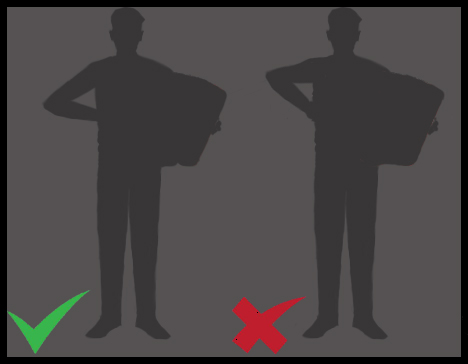
So, you having the right posture has a big role to play. There will be some songs or pieces that you might get stuck on simply because your posture is faulty and this will hinder your progress.
Once again, check out the article on how to hold the accordion. It will help you out a lot.
-
Be focused and avoid distractions
As you practice, try to clear your mind and just think about the music you are playing. Get rid of all thoughts and just focus on what you’re doing. It may help to leave your cell phone in another room to avoid distractions. Keep only what you need, a chair, a music stand, a pencil, sheet music, a metronome and your accordion.
-
Split the score into sections
When learning a new piece, split the score into sections and classify them accordingly to their difficulty. Always start from the hardest part. This way, as you progress, it will get easier and easier and you won’t be too tired to complete the study of that piece.
-
Practice with the metronome
Always practice with the metronome. Start very slowly then increase the tempo only when you can play without making any mistakes. If you make mistakes it means that you are playing too fast hence you have to find a speed so slow that doesn’t allow you to miss a note or make mistakes. Sometimes you need to stay on the same bpm (beats per minute) for a long time before increasing speed, be patient.
-
Practice always at the same time
To optimize your practice, you should play every day, possibly at the same time. This is to make our practice sessions less stressful: it works because your brain likes routine. For the first few days, it may be tiring, but after a few weeks it will become a habit and therefore you’ll be more willing to repeat it in the following days.
-
Write the fingering
Pay attention to fingering: when you have to learn a new piece, mark the fingering on the score. Always practice with that fingering, don’t improvise it.
-
Mark bellows inversions
To avoid running out of air, you need to know when to reverse the bellows and learn to control its movement.
Take a pencil and mark on the score the points where you need to reverse the bellows.
-
Contraction & expansion of the right hand
This tip is for intermediate and advanced accordionists who are practicing hard pieces: convert the melody notes into groups and then into chords. To understand what I mean, watch this piano tutorial from Paul Barton:
By converting the melody into chords, you force the hand to assume the right position to be able to play all the notes simultaneously, so when you play one note at a time it will be much easier to play some intervals because you will have strengthened your muscle memory.
Maybe this trick is not useful for all pieces but in some cases, it’s the best way to learn certain complex parts.
-
Record your progress
Once a month or even more often, record your practice sessions. This will show you clearly your progress and it will motivate you to be consistent.
What to practice
Do you know that you can spend hours practicing the wrong stuff? During your practice session, you have to practice the right stuff to get good results. People don’t get better at something by accident. It comes with being intentional about progress and discipline.
There are 4 main areas to look out for during every practice session. Of course, not all of these should be practiced at once but these are just the areas you want to focus on, and how well you practice these, shows how long it will take you to make progress on the accordion.
- Technique building
- Ear training
- Music theory
- Repertoire
Technique building
This area is very important as it shows proficiency and efficiency when properly developed. The poorer your technique, the longer it will take you to expand your repertoire.
Let’s talk about a few areas of technique building.
- Right-hand technique
- Left-hand technique
- Coordination between the left and the right hand
Right-hand technique:
It’s important to include a variety of scales and chords in your practice routine. This should include major scales, minor scales (natural, harmonic, and melodic), as well as chords such as major, minor, diminished, and 7th chords. By practicing these elements, you will gain a deeper understanding of how they work together and be better equipped to express yourself creatively through your playing. Arpeggios and chord inversions should also be practiced. There are a lot of exercises that you can incorporate into the practice session that will give you absolute control and efficiency of your right hand, for example, a very popular book of exercises is the Hanon. They are excellent warm-up exercises and are very useful for strengthening the fourth and fifth fingers of the right hand.
Left-hand technique:
Your left-hand technique is more demanding than its counterpart because it is performing two tasks at once, squeezing or stretching the bellows and pushing bass and pre-set chord buttons. It is common for beginner accordionists to have problems with the left hand and it takes some practice and patience to get used to it.
One common problem faced by beginner accordionists is “running out of bellows”. Most beginners aren’t sure how far to stretch or squeeze the bellows, especially between phrases in songs or pieces. For this reason, as I said earlier, you should mark the bellows inversions on the score.

Another common problem is having difficulties reaching for chords and bass buttons without having to always look down at the buttons. Practicing the left hand, rely on your sense of touch, don’t try to look at the buttons, and don’t use mirrors, develop a solid muscle memory instead.
Always practice with the correct fingering: 4-3-2-3 for alternating bass on Major chords and 4-2-3-2 for alternating bass on minor, seventh, and diminished chords. Using alternative fingerings like 3-2-3-2 only works up to a certain speed, as you have to keep moving the same finger to two different positions very quickly. Combined chords are often in a stretched position, so if you are not comfortable using your 4th finger on the root you may have some difficulty playing this type of chord. For this reason, I suggest using the 4th finger on the root as it will bring some benefits in the long run. After a few months after the first time you held an accordion, start practicing major and minor scales even with the left hand.
Coordination between the left and the right hand:
It is a very common problem among beginner accordionists to have their left hand clashing with their right hand. This happens because of a lack of coordination between the two hands. The hands haven’t yet learned the art of independence and this takes some time to master. There are a lot of exercises you can do to master hand independence on the accordion but the faster way to achieve good coordination is by playing slowly so your brain has the time to process all required tasks.
In this video, Lucy Riddett explains how to improve your coordination using a practice technique called “Ghosting”.
(In my opinion, Lucy Riddett has created some of the best video tutorials for beginners accordionists you can find on YouTube.
I highly recommend subscribing to her YouTube channel.)
Ear Training
There are a lot of benefits to having a “good ear” as a musician, especially as an accordionist. This is a very expansive subject and in future lessons, it would the discussed a lot better. The point is that you have to train your ear to recognize scales, chords and, progression even if you are used to relying on sheet music.
Music Theory
Music theory simply teaches you the elements of music such as rhythm, harmony, melody, improvisation, and a whole lot more. This knowledge is particularly useful for accordionists, as it can help them better understand and communicate with other musicians, especially when performing with other instrumentalists. Musicians can communicate effectively with each other only if they speak the same language: music theory is this language and it’s the same all over the world.
Repertoire
The songs or pieces that you can play effortlessly are your repertoires as an accordionist. This is the main reason why we learn the accordion, to be able to play songs. As a beginner accordionist, attempting to play Paganini’s famous classical piece won’t do you any good. As a beginner, it is okay to start with simple songs, even with nursery rhymes, then, as you advance, you can attempt more difficult pieces.
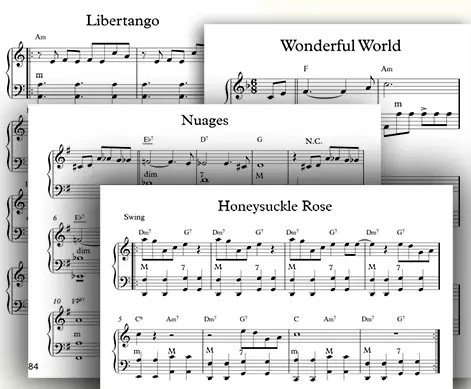
Always start slowly when learning a new piece. As I said, always use a metronome when practicing. The famous saying “if you can play it slowly, you can play it fast” applies to the accordion as well.
8. Motivation
How motivated are you to pick up your instrument? This is a question that must be sincerely answered by you. What is the main reason for you deciding to pick up and play the accordion? You just have to be motivated and encouraged to pick up your accordion to practice every day. A lack of motivation leads to skipping practice sessions, which means, ceasing to progress or in the long run, even completely losing the ability to play. Solid motivation translates into discipline which is the virtue needed to achieve any result in any field.
Tip: Don’t always pack your accordion into its case after every practice session. Leaving it lying around the house in an open space is what you want to do. By doing this, you can always pick it up because it is within your sight as opposed to you packing it inside its case.
Conclusion
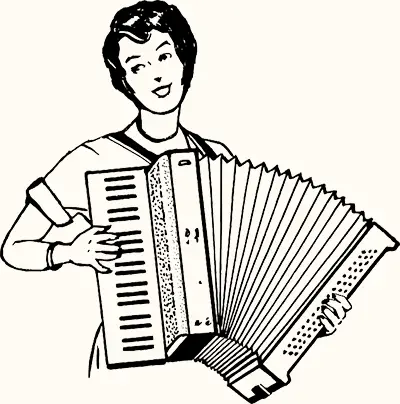
Although it’s not possible to know exactly how long it will take to learn to play the accordion, this is a prediction based on my experience as a teacher:
| Beginner | 2 weeks up to 2 months. |
| Intermediate | 1 or 2 years to reach this level but it could take longer. |
| Advanced | 4 or 5 years of experience. |
| Expert | decades of practice and performances. |
(Note that this view is subjective as there are other factors to consider)
Learning the accordion and becoming a master of it is a lifelong process. Learning to play simple pieces it’s easier but whatever your goal is, you just have to keep on practicing day by day in a proper way.
(Vignettes are taken from “IN TUNE WITH FUN” – 1950s Comic Book on Accordions)
Thanks for reading!
Author: Giovanni Lucifero
This site and tuto are exactly what I was looking as an almost new player.
The chart of bass chords is very helpful to me. This is the only website I found presenting these informations clearly and exhaustively.
Thank you very much Giovanni!
Do you have in mind training material to recommend about the technical skills with piano accordion, left hand and right hand.
Soften fingers, improve accuracy and speed, etc
Thanks again
Thank you so much for your appreciation!
To improve the technique I can suggest to practice daily scales (major and minor, with both hands, in unison and harmonized in 3rd, in reverse movement), chord arpeggios (major, minor, seventh, diminished, augmented) and Hanon.
Always practice with a metronome and mark the speed for each scale and exercise.
Start slowly and increase the time gradually, don’t skip steps.
I know … nothing special but it works!
Brilliant I am 59 and I will do everything to learn the accordion
Hi Domenico,
yeah, this is the right mindset!
Thank you for your comment!
Thank you so much for these guides and tutorials, Professor Giovanni.
I want to become a great accordionist one day and your site will help me a lot.
Best regards,
Jaime
I forgot to mention,
I’ve been teaching myself how to play the accordion since a year ago, and I know all the people you have mentioned on this article.
We are a bit of a little community here, are we not?
We should organize a convention one day!
Jaime
Thank you for your kind words, Jamie!
I am glad that my guides and tutorials have been helpful to you.
It’s great to hear that you have been teaching yourself to play for a year and that you are familiar with the accordionists mentioned in my articles. The accordion community is indeed a small one, and it’s always wonderful to connect with other enthusiasts and share our love for this instrument.
Thank you for reaching out and for your support! I wish you all the best in your accordion journey and I hope you continue to find my resources helpful!
Excellent advice. I’ve been playing piano accordion 10 years and I am a slow learner, but I do compose tunes.
I’m going to keep busking with my Weltmeister Perle for now as my repertoire is only 1 hour.
Best of luck everyone.
Thank you John!